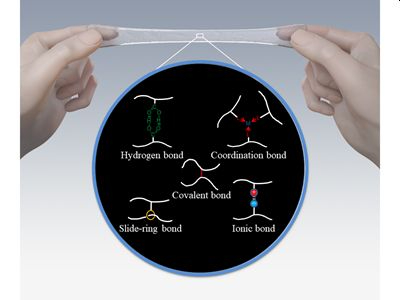Elastomers Develop Stronger Bonds Of Attachment
Molecular interactions within gels and rubbers can be controlled to fabricate stronger and more elastic materials.
Tsukuba, Japan, Feb 12, 2021 - (ACN Newswire) - Elastomers are the soft, elastic materials, like gels and rubbers, that are found in automobile and airplane parts, in sports equipment, and are used to protect precision machinery and buildings against vibrations. Scientists now want to make them thinner and tougher, without losing elasticity. Nagoya University materials engineer Yukikazu Takeoka and colleagues reviewed the most recent efforts towards improving elastomers for the journal Science and Technology of Advanced Materials.

"Our review gives hints about the kind of molecular thinking that needs to go into making elastomers tougher," says Takeoka.
Elastomers are made of many, long molecular chains of repeating subunits. They can undergo large deformations when stretched, returning to their original shape when the tension is released. They can do this because their molecular chains have enough mobility to stretch and crunch up.
Elasticity and overall toughness depends on the interactions between the molecular chains inside the material. Scientists have been working on controlling how chains link together and interact in order to change elastomers' mechanical properties.
Takeoka and his team from Nagoya University's department of molecular and macromolecular chemistry explain that elastomers can be made tougher by introducing strong hydrogen or ionic bonds that can reversibly link elastomer chains together. These reversible bonds attach and detach from the elastomer chains as the material deforms. Scientists have used hydrogen bonds to fabricate strong hydrogels that can deform up to 600% and return to their original state within three minutes at 37 degrees Celsius or a few seconds at 50 degrees Celsius.
Elastomer chains can also be linked through ring-like 'cyclic' molecules, giving linked chains a large degree of flexibility and improved toughness. A team of scientists fabricated a very flexible elastomer by mixing solutions of polyethylene glycol and cyclic alpha-cyclodextrin in water.
Takeoka and his colleagues suggest that further combining elastomers linked by reversible bonds and moving cyclic molecules could lead to even tougher elastomers with better elongation. "Our review emphasizes the importance of examining molecular behaviour in detail while designing polymer materials," says Takeoka.
Paper: https://www.tandfonline.com/doi/full/10.1080/14686996.2020.1849931


 Alternative Jewish Voices: On International Day Of Solidarity With The Palestinian People, Jews Across The Globe Stand With Palestine
Alternative Jewish Voices: On International Day Of Solidarity With The Palestinian People, Jews Across The Globe Stand With Palestine Aotearoa Healthcare Workers For Palestine: Wellington Healthcare Workers Marking One Year Of Weekly Vigils For Palestine
Aotearoa Healthcare Workers For Palestine: Wellington Healthcare Workers Marking One Year Of Weekly Vigils For Palestine Independent Media Institute: The Sustainability Scam: How Self-Interest Ruins Good Ideas
Independent Media Institute: The Sustainability Scam: How Self-Interest Ruins Good Ideas United Nations: UN Welcomes Ceasefire Between Israel And Lebanon
United Nations: UN Welcomes Ceasefire Between Israel And Lebanon UN News: One Woman Killed Every 10 Minutes - The Harrowing Global Reality Of Femicide
UN News: One Woman Killed Every 10 Minutes - The Harrowing Global Reality Of Femicide Fulbright New Zealand: Announcing The 2025 Ian Axford Fellows In Public Policy
Fulbright New Zealand: Announcing The 2025 Ian Axford Fellows In Public Policy